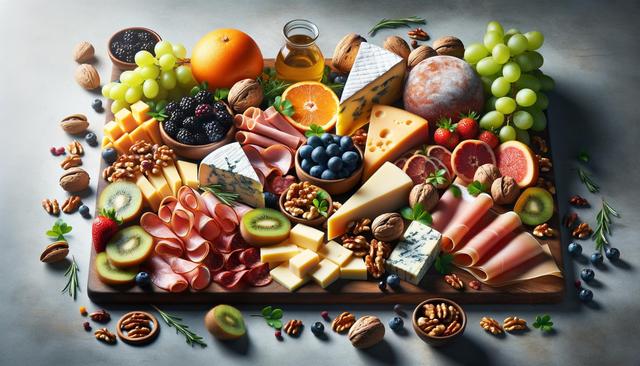What Makes Grazing Boards So Appealing?
Grazing boards have quickly become a centerpiece of modern entertaining thanks to their vibrant presentation and interactive nature. Unlike traditional plated meals, these boards invite guests to explore a variety of flavors and textures at their own pace. Visually, they’re a feast for the eyes—carefully arranged with colorful fruits, cheeses, dips, and more, creating an inviting and photo-worthy spread. The beauty of grazing boards lies in their ability to blend artistry with function. Hosts can express creativity through design and ingredient selection, while guests enjoy a relaxed, communal dining experience that encourages conversation and connection.
Incorporating diverse ingredients not only enhances the aesthetic but also ensures inclusivity. Rather than adhering to a fixed set of items, grazing boards can cater to various dietary needs and preferences. Whether vegan, gluten-free, or dairy-sensitive, the format allows for meaningful representation of all guests at the table. With increasing awareness around food sensitivities and cultural inclusivity, grazing boards have evolved into a contemporary solution for thoughtful hosting.
Moving Beyond Traditional Charcuterie
While traditional charcuterie boards focus on cured meats and cheeses, modern grazing boards expand far beyond those boundaries. Entertainers now incorporate a broad range of elements to reflect global influences and dietary trends. Think Mediterranean-inspired spreads with hummus, olives, and pita; Asian-themed boards with sushi rolls, edamame, and pickled vegetables; or fully plant-based versions featuring roasted vegetables, nut-based cheeses, and fresh fruit. The possibilities are as limitless as the culinary imagination.
This shift is partly driven by a desire to move away from meat-centric offerings. As more people adopt plant-forward lifestyles, there’s a growing demand for alternatives that still feel indulgent and festive. Grazing boards make it easy to accommodate this change without sacrificing variety or taste. A balanced board might include:
- Assorted crackers and breads
- Fresh and dried fruits
- Roasted or marinated vegetables
- Flavored nuts and seeds
- Homemade or store-bought dips
These additions not only support different dietary needs but also create a more dynamic and colorful visual layout.
The Art of Arrangement
One of the defining features of a successful grazing board is its layout. The arrangement plays a crucial role in how appealing—and functional—the board is. A well-balanced board uses symmetry, color contrast, and layering to guide the eye and encourage guests to sample a variety of items. While there’s no single formula, a few key principles can elevate the presentation:
- Start with anchor items like cheeses or bowls of dip
- Build around these with complementary items in varied shapes and colors
- Use greenery or edible flowers for a finishing touch
Incorporating different textures—crunchy, creamy, soft, firm—adds depth not only to the look but also to the tasting experience. This thoughtful approach turns the board into more than just a snack tray; it becomes a curated experience that delights all the senses.
Additionally, size and shape matter. Round boards offer a natural flow for circular arrangements, while rectangular trays can be divided into sections for different themes or flavor profiles. The choice of serving surface can further enhance the experience, from rustic wooden boards to sleek slate platters.
Inclusive and Culturally Inspired Entertaining
Grazing boards are uniquely positioned to celebrate cultural diversity through food. Hosts can use them as an opportunity to introduce guests to new cuisines or honor family traditions. For example, a Middle Eastern-inspired board might feature baba ghanoush, dates, figs, and flatbreads, while a Latin American theme could include plantain chips, queso fresco, and spiced nuts. These thoughtful inclusions create a welcoming and educational atmosphere, allowing food to become a bridge between cultures.
Furthermore, grazing boards lend themselves well to seasonal and regional variations. A spring board might highlight fresh peas, radishes, and herbed cheeses, while a winter version could focus on dried fruits, nuts, and hearty breads. This adaptability encourages sustainable choices and supports local producers, aligning with more conscious entertaining practices.
For hosts who want to reflect their guests’ backgrounds or honor specific traditions, grazing boards provide a flexible, celebratory format. They can be as casual or as refined as desired, making them suitable for everything from backyard get-togethers to upscale events.
Tips for Building a Crowd-Pleasing Grazing Board
Creating a well-balanced grazing board doesn’t require professional training—just a bit of planning and creativity. The key is to think in terms of variety and inclusion. Here are a few practical tips to keep in mind:
- Offer a mix of flavors: salty, sweet, tangy, and savory
- Include options for different diets: plant-based items, gluten-free crackers, nut-free alternatives
- Use small bowls or ramekins to contain messy items like spreads or pickles
- Label ingredients if serving a large group or if allergies may be a concern
Portion size is another consideration. Aim for enough variety to satisfy your group without overwhelming the board. A good rule of thumb is to include a few pieces of each item per person. Replenish as needed rather than overcrowding from the start.
Finally, don’t forget the utensils. Small tongs, cheese knives, and spoons make it easier for guests to serve themselves hygienically and comfortably. Thoughtful presentation and ease of access go a long way in creating a seamless and enjoyable experience for everyone involved.
Conclusion: Elevating the Art of Sharing
Grazing boards represent a shift toward more inclusive, interactive, and visually engaging ways of entertaining. They embrace creativity, cultural diversity, and dietary awareness—all while encouraging communal enjoyment. Whether you’re hosting a casual gathering or a more formal occasion, these spreads offer endless possibilities for customization and expression. By focusing on balance, variety, and thoughtful presentation, grazing boards can be a memorable and meaningful centerpiece for any event. As modern hosts look for ways to entertain with intention, this fresh take on shared dining continues to grow in popularity—and for good reason.
